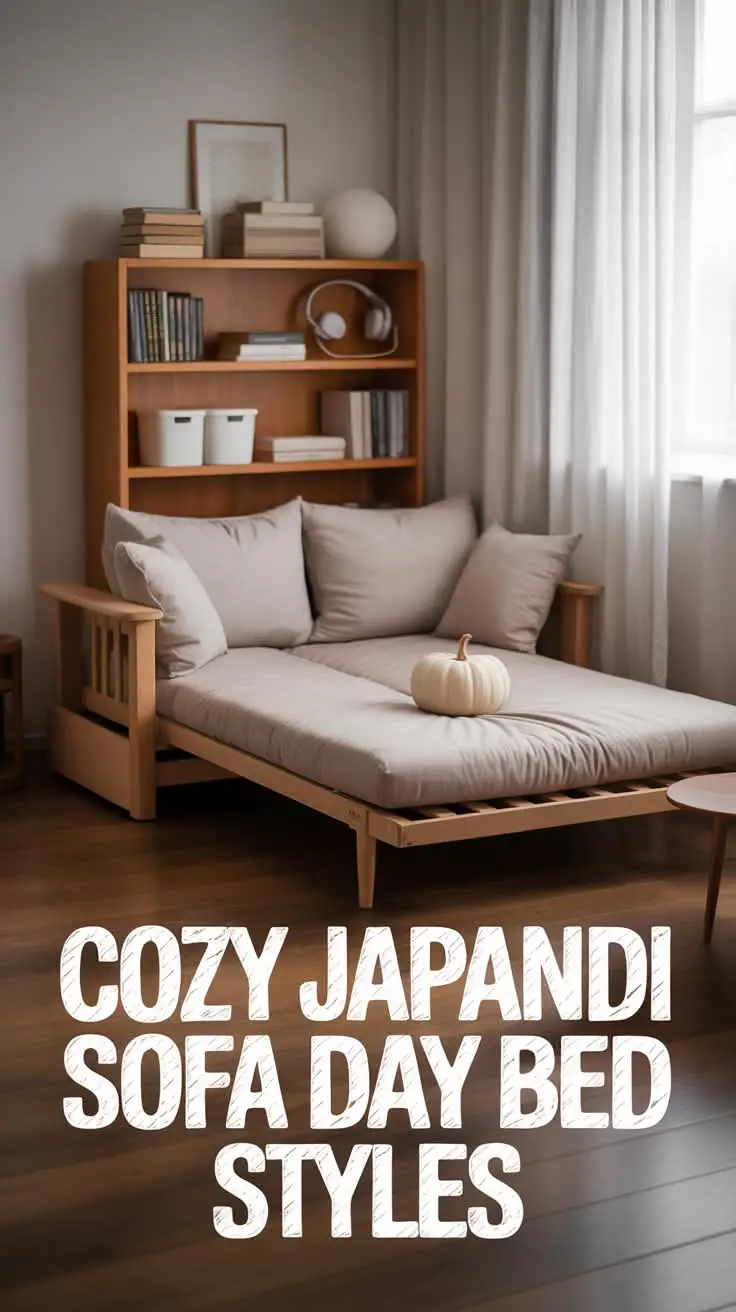Let’s start with a confession: most living rooms are arranged for the person who never sits down—tidy vignettes, a sofa that faces a TV nobody admits to owning, and a coffee table that’s always one book shy of a personality. Then there’s the daybed: part chaise, part bench, part “don’t mind me, I’m just horizontal at 3 p.m.” It’s furniture with an agenda—yours. It says this room is for living, not just perching like a nervous flamingo on the edge of a sofa cushion.
If sofas are the heavy lifters and armchairs are the conversationalists, the daybed is your wildcard: a sculptural lane-keeper that can also host your afternoon nap, unexpected guest, or sulky teenager. It’s the piece that makes a room flow—visually, socially, emotionally—because it doesn’t insist on being the star. It plays wingman, air-traffic control, and chaise-longue therapist all at once.
Below: eleven ways to use a daybed that’ll have your living room moving like a well-oiled playlist.
1) The Modern Wingman: Keep It Sleek, Keep It Moving
Think slender frame, tight upholstery, legs you can actually see under. Modern daybeds behave like visual commas, not full stops. Slide one parallel to a staircase or along a circulation path and you’ll get seating without the visual bulk. Tan leather or tight-weave wool reads “grown-up,” but the real magic is that low profile: it keeps sightlines open, conversations easy, and egos small.
Styling move: match the wood tone to your floor, then offset with one audacious accent (a berry-red banister, a glossy lacquer side table). You’re not trying to shout; you’re trying to nod with swagger.
2) Sculptural Show-Off: Treat It Like Art You Can Nap On
A timber-framed daybed with graphic geometry or exaggerated curves doubles as a small-scale installation. Line it up with your room’s architecture—mouldings, beams, grid shelves—and let the dialogue happen. Angular room? Choose a crisp profile. Curvy room? Bring in something bulbous and upholstered so it reads like a soft punctuation mark.
Test: If you cleared the room and left only the daybed, would it still look intentional? If yes, you’ve got sculpture.
3) The Color Pop: Put Red in a Blue Room (and Don’t Apologize)
Because the daybed sits low, it’s the safest place to go bold. Deep red velvet in a pale blue room? Yes. Citrus boucle under a moody charcoal wall? Still yes. The color sits below your eye line, so the room stays calm while your daybed does a little dance.
Formula: neutral envelope + punchy daybed + two tiny echoes (a book spine, a vase) = effortless palette.
4) The Upcycled Drama: Convert a Bed, Tell a Story
Got a bed frame loitering in the attic? Chop the legs, reupholster a cushion, pile on throws, and you’ve got a bespoke daybed with a backstory. Four-poster variations frame a window like a stage and make even a modest room feel ceremonial. Add lattice panels or caning and you’ve basically adopted a functional heirloom.
Pro-tip: If the frame’s large, keep the textiles toned down—think natural linens, slubby cottons—so it reads architectural, not theme-park.
5) Multitasker-in-Chief: Entry Bench, Reading Nook, Secret Guest Bed
Backless and armless daybeds are design shapeshifters. Pop one near the front door for shoe-tying and parcel-opening. Spin it ninety degrees and it becomes a conversation bridge between two chairs. In a studio, dress it by day as sleek seating, strip it by night and boom—guest crash pad.
Fabric sanity: families + pets = performance textiles. Look for tight weaves, crypton finishes, or indoor/outdoor fabrics that don’t feel like boat covers.
6) The Gentle Partition: Divide Without Building a Wall
Open-plan rooms love a daybed because it breaks zones while keeping sightlines clean. Float one between the lounge and dining area; the backless silhouette invites conversation on both sides without creating a furniture barricade. It’s a velvet rope, not a brick wall.
Layout tip: put a slim console behind the daybed to hold lamps and trays. You get a “back” without adding bulk.
7) Sofa Swap in a Small Room: Lighter Than a Couch, Heavier Than a Chair
Small living room, big attitude? Replace the hulking sofa with a streamlined daybed and watch the space breathe. The footprint shrinks, the vibe expands, and your floor suddenly looks like square footage you paid for, not a landing pad for upholstery.
Keep it airy: neutral fabric, slim legs, minimal cushions. The goal is “intentional negative space,” not “we forgot to buy a sofa.”
8) Corner Whisperer: Fill the Awkward Void (and Store the Throws)
Those weird dead zones—under a window, beside a bookcase, the corner where plants go to perish—are daybed catnip. Tuck a piece into the nook, color-match it to the wall for a custom feel, and stash baskets beneath for pillows and blankets. Instant reading perch, instant purpose.
Light matters: aim a floor lamp across the daybed to create a slice of sunshine at 9 p.m. The corner becomes a destination, not a timeout chair.
9) Built-In Brag: Go Custom and Never Look Back
A built-in daybed turns one wall into a zone: seating, storage, serenity. Add drawers for board games, cubbies for vinyl, or a charging ledge for devices. It’s pricy, yes—but it will behave like architecture, which is posh-person code for “worth it.”
Make it sofa-adjacent: bolster cushions along the back, large square pillows at the corners. Your “bed” reads like a tailored banquette with nap rights.
10) Niche Perfect: Slot It Between Shelves and Call It a Library
If you’ve got the world’s most inconvenient recess, stop fighting it and slide in a daybed. Suddenly you’ve made a micro-library: books to the left, books to the right, you in the middle questioning life choices and lighting a candle about it. Add a martini-sized side table and you’ve created a think tank.
Study mode: clip a plug-in sconce to the shelf, aim it down the cushion, and pretend you’re writing your novel.
11) Ground Game: Go Low to Make the Room Feel Huge
In large spaces, a traditional second sofa blocks sightlines and hogs oxygen. A low-slung daybed—practically skimming the floor—gives you seating without the visual noise. It tucks under windows, beneath oversized art, even in front of a fireplace (when not in use), making the whole place read gallery-big.
Styling: single long lumbar + wool throw. Keep it minimal so the scale trick works its sorcery.
Can a Daybed Replace a Sofa?
Short answer: yes. Longer answer: pick the right type. Upholstered on three sides with a decent cushion? It’ll sit like a sofa and lounge like a chaise. Backless planks with no padding? Lovely for a cocktail hour; questionable for a Netflix bender unless you enjoy chiropractor punch cards. If the goal is couch replacement, choose a sturdier build, add bolsters, and aim for mattress-level comfort without, you know, looking like you dragged your bed into the lounge.
Where Should It Go?
Anywhere you want your life to actually happen. The living room is the obvious choice because it’s your social stage, but daybeds are fearless: under a low window (borrowed light), along a weirdly long wall (stops the bowling-alley vibe), between shelves (library nook), even floating in the center (conversation island). If it’s lightweight, move it around like a chess piece—kids’ room for a sleepover, guest room for extra seating, balcony if the materials won’t wilt at the first hint of weather.
How to Make It Actually Comfortable
Comfort is a three-part equation:
- Cushion density: medium-firm seat with enough loft to avoid the “sinking canoe” effect.
- Support pieces: two bolsters for lounging spine support; a couple of square throws for upright chatter.
- Textiles: breathable fabrics (linen blends, cotton boucles, wool felts) so you don’t peel yourself off in summer or freeze in winter.
Bonus: a throw with some weight. It says “stay a while” without you saying anything at all.
How Daybeds Fix Flow (The Boring Bit That’s Actually Crucial)
Flow isn’t vibes; it’s geometry. Sofas demand orientation—face the TV, the fireplace, the big window—like bossy rectangles. Daybeds float, pivot, and invite diagonal movement. They compress space where you need intimacy and relax it where you need circulation. In plain English: guests stop bottlenecking behind the sofa, you stop barking “mind the lamp,” and the room finally acts like a room instead of a furniture warehouse.
Try this: put tape on the floor where people naturally walk. If your current seating chops that path in half, swap in a daybed parallel to the traffic line. Watch chaos recede.
Quick-Fire Combos (Steal These)
- Neutral room + spicy daybed: oatmeal walls, walnut coffee table, paprika velvet daybed.
- Pattern shy? Keep the daybed solid; pattern the bolster only (stripe or houndstooth).
- Monochrome trick: charcoal daybed + black-framed art + slate rug = rich, not gloomy.
- Beach-but-not-kitschy: sand linen daybed, bleached oak legs, indigo lumbar. No seashells were harmed.
Pitfalls (So You Don’t Do Daybed Jail)
- Too tall: if the seat height matches your sofa but the back is nonexistent, it can look like a weird twin. Go lower or slimmer.
- Too flimsy: if it wobbles when you sneeze, it’s a cat shelf, not seating.
- No plan for pillows: backless doesn’t mean back-ache. Budget for bolsters.
- Rogue color splash: one neon daybed with zero chromatic friends looks like a traffic cone. Echo the hue somewhere else.
Maintenance Without Tears
Vacuum the crevices (crumbs are loyal). Rotate the cushion every few weeks so your favorite corner doesn’t develop a permanent you-shaped trough. Spot-clean like a pro: dab, don’t scrub. And if you chose performance fabric, smile smugly while everyone else panics over Merlot.
The Takeaway
A daybed is the most hard-working piece you can add to a living room: flexible like a bench, comfy like a chaise, sociable like a sofa, and stylish enough to masquerade as sculpture. It untangles traffic, opens sightlines, and gives you permission to nap within arm’s reach of your coffee table. Put one where the room feels stuck, and watch the whole space exhale.
It’s not a trend; it’s a lifestyle choice—like choosing to be horizontal whenever possible.



